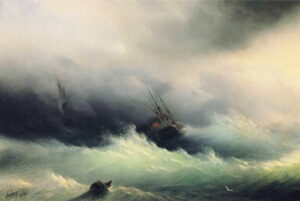Sibelius, The Oceanides
After Wellerman last week, we might as well continue with the sea theme. Artists have found numerous ways to portray the natural elements. For composers, it’s a bit more complicated since music lacks the concrete imagery that can be found in other arts.

Musicians are more likely to portray movement, a quality which music expresses quite well. Water and wind are prime examples. A stationary, inanimate object is more problematic. Keats could write Ode to a Grecian Urn extolling the qualities of an such an object (although it’s interesting to note the pervasive imagery of music in that poem). But musicians rarely choose rocks or utensils for subjects. What about Grofé’s Grand Canyon Suite, you say? Well, that tends to focus on events happening within the canyon—things that move—and not the rocks themselves.
But the sea has all the qualities a composer could hope for: movement, changing colors, overwhelming size and power, and an allure that has always drawn men to venture into its dangerous realm. Being married to Professor Carol has allowed me to make numerous sea voyages, and it’s hard not to be constantly impressed by the ocean. (Of course, being on the ocean in what is essentially a luxury hotel allows you to ignore the realities whenever you want, and the waiters didn’t sing sea shanties as they prepared our table-side flambés.)
Jean Sibelius made a similar voyage by sea to the United States in 1914 (probably no less luxurious) where he conducted the premiere of this tone poem Oceanides. The famous music critic Olin Downes called it “the finest evocation of the sea that has ever been produced in music” while taking a dig at Debussy’s La Mer. Oceanides is filled the atmospherics of the sea, the undulations and density. It is a powerful portrayal, and you may feel a little wet and relieved to be back on shore when it’s over.



